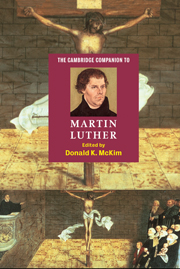15 - Approaching Luther
from Part III - After Luther
Published online by Cambridge University Press: 28 May 2006
Summary
THE PERSON AND THE SYMBOL
Martin Luther the historical figure assigned to teach biblical studies at an obscure university in the eastern part of what is now Germany and Martin Luther, cultural symbol, parted company on or about October 31, 1517, and have had an unpredictable relationship ever since. Assessing the differences is the critical task in approaching this compellingly attractive and equally repugnant man.
The historical dimensions of Luther's life follow a familiar pattern. The son of an upwardly mobile miner, Hans Luder or Ludder, and of the daughter of a fairly prominent family, Margarethe Lindemann, he was set aside for a career in law. In the course of his studies, Luther believed himself to have been redirected toward a religious vocation – a crossover well known to law and theological faculties. When he took orders as an Augustinian monk, Luther attracted a mentor, Johan von Staupitz, who promoted his career, moving him forward in the order.
Luther’s academic career was also fairly routine, at least in its outline. Upon completion of the doctorate, while taking his share of pastoral duties, the young monk was assigned to teach courses in Old and New Testament at the University of Wittenberg, a town of 2,000 that was the capital of Electoral Saxony. As a teacher, he was caught up in an occupational hazard of academic life: academic, churchly, and political polemics. Though his personal circumstances changed – most dramatically in being excommunicated, outlawed, and for all of this, marrying – Luther continued his vocation until his death, in February of 1546. If events had not combined to put him in a symbolic spotlight, the story would have ended right there.
- Type
- Chapter
- Information
- The Cambridge Companion to Martin Luther , pp. 240 - 256Publisher: Cambridge University PressPrint publication year: 2003



